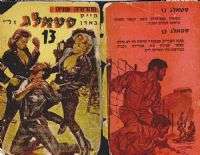Stalag fiction
Stalag (Hebrew: סטאלג) was a short-lived genre of Nazi exploitation Holocaust pornography in Israel that flourished in the 1950s and early 1960s, and stopped after the time of the Eichmann Trial, because of a ban by the Israeli government.[1] These books did not include Jews to avoid taboos. They are no longer available for a reading today in terms of traditional publication, although the advent of the Internet has allowed for peer-to-peer file sharing.

Premise
Purported to be translations of English-language books by prisoners in concentration camps, these books were highly pornographic accounts of imprisonment, generally of Allied soldiers, sexual brutalization by female SS guards (or in some cases by Imperial Japanese women), and the prisoners' eventual revenge, which usually consisted of the rape and murder of their tormentors.[2] The books, with titles like I Was Colonel Schultz's Private Bitch, were especially popular among adolescent boys, often the children of concentration camp survivors.
History
The books emerged from the culture of silence that surrounded the Holocaust, especially in Israel, until the Eichmann trial. Many young people lived in the shadow of these events, but could find no answers to their inevitable questions, whether from their parents or their teachers. For most of adolescents, the only answers they could find were in the book House of Dolls (1955) a novella by K. Tzetnik, a then-anonymous survivor of Auschwitz who wrote about women prisoners forced into prostitution by the Nazi guards. Although published as fiction, the book has been considered a partially truthful account based upon the experiences of the author's sister.[3] It affected young Israelis as they went through puberty: questions of identity and their parents' violent past melted into their emerging sexual identity. This became more prevalent during the highly publicized Eichmann trial, when these same young people were exposed to detailed descriptions of the concentration and death camps for the very first time. K. Tzetnik himself was one of the witnesses who provided graphic testimony during the trial.
Exploiting these trends, a group of Israeli publishers began to publish dime novel-format memoirs, describing abuse, particularly sexual abuse, in the concentration camps. Sold in magazine kiosks, the novels, ostensibly first-person memoirs, became best-sellers. According to filmmaker Ari Libsker, "the Holocaust pictures that I saw, as one who grew up here, were of naked women."[4]
They disappeared almost as quickly as they appeared. Within two years of the appearance of the first publication, the publishers were accused by an Israeli court of distributing pornography and the books were discontinued. Although still available underground, certain titles earned the ire of the establishment, and efforts were made to find and destroy them. The advent of the Internet has allowed for peer-to-peer file sharing and thus made censorship attempts far harder.
In 2003, the genre re-entered public debate in Israel with the research of popular culture analyst Eli Eshed. As a result of that research, Israeli filmmaker Ari Libsker featured the books in a documentary film, which was titled Stalags.[5]
References
- http://www.sfjff.org/film/detail?id=3929
- "Documentary looks at Nazi porn in Israel". UPI. 2007-09-06.
- Mikics, David; (August, 2012). "Holocaust Pulp Fiction". Tablet Magazine. http://tabletmag.com/jewish-arts-and-culture/books/97160/ka-tzetnik
- Isabel Kershner (2007-09-06). "Israel's Unexpected Spinoff". The New York Times.
- cinephil.co.il
External links
- Daniel Kothenschulte. "Oberst Schultz und seine Hündin". Frankfurter Rundschau.
- Village Voice